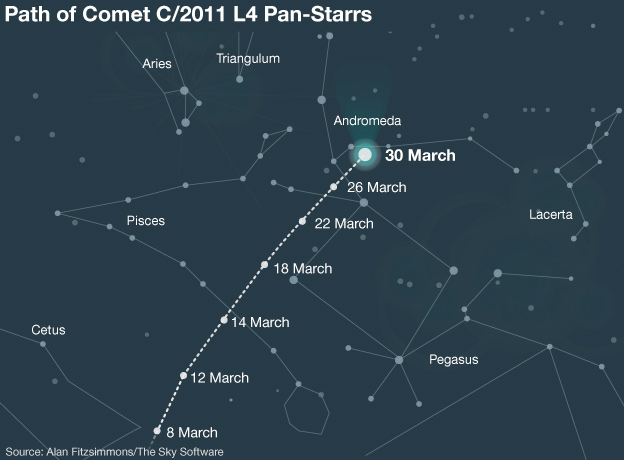C/2011 L4 Pan-Starrs Comet
The second Comet this year will be lighting up our skies over the next few nights. This one, named C/2011 L4 Pan-Starrs, was visible using binoculars or a telescope from the 8th March and will become brightest on the 10th March with the best days to view it being on the 12th and 13th as it is in a great place in the Sky to be able to pick it out. At this point, provided it is a clear sky, you should be able to see it with the naked eye.
It should be pretty straightforward to spot as it is close to the crescent Moon in a western direction. To find the Comet, find the Moon just after sunset, and look down and slightly to the left of it. With binoculars you should see the head of the comet very clearly and even the two types of tails coming from it. As the month rolls on, the Comet will appear higher and higher in the sky and later in the evening until it disappears when we reach the month of April.
Comet C/2011 L4 Pan-Starrs was first discovered in June 2011 and is believed to originate from the Oort Cloud. It was picked up in Hawaii by the Pan-Starrs telescope, which is why they have given the Comet its name. Scientists believe that this could be the first time it has appeared in our system as they believe it is a non-periodic Comet, and it may not return for another 100,000 years. So it is definitely a once in a lifetime Comet!!
The Comet itself is thought to have a nucleus of about 20-30KM in diameter but due to the dust and material surrounding it, it could well span more than a million kilometres which is insane to think about in my opinion!
Professor Mark Bailey, director of the Armagh Observatory in Northern Ireland, has said this about the new Comet, “We have great hopes for this comet. Of course we are always very cautious – even now we don’t know how bright it is going to get – but we are keeping out fingers crossed.”
He also said, “After sunset, scan the horizon roughly in the western direction. On the 12 and 13 March, there is a nice association with the thin crescent Moon. You can use the Moon as a guide, and search just down or to the left of the Moon. Through binoculars you should be able to see the head of the comet and certainly the two types of the tail. I would always advise people to hunt for comets with binoculars, but if you have found it with binoculars, have a good hunt around and see if you can see it with the naked eye. That’s quite a challenge – but it is a wonderful thing to have seen.”
Below is an image of the path of the Comet in our night sky in March, so enjoy Comet hunting over the next couple of days and weeks.
Let me know if you see it by either leaving a comment here or tweeting me at @strethewey #nightskyastronomy.
